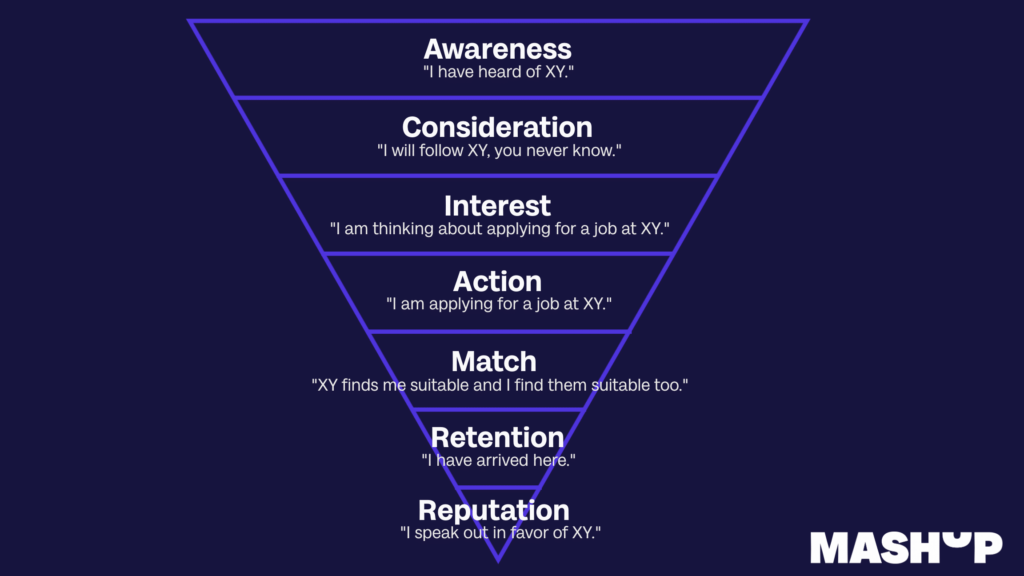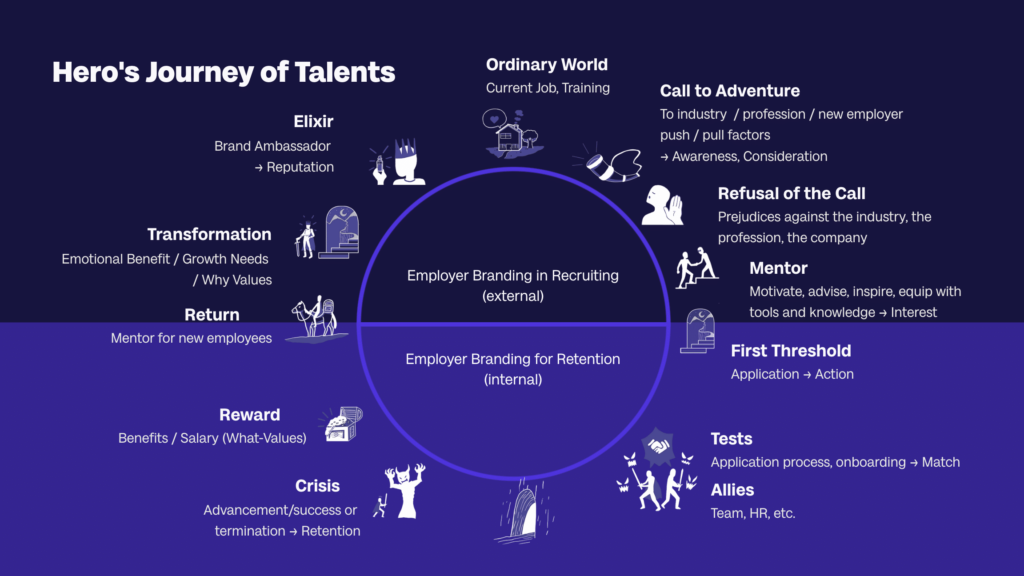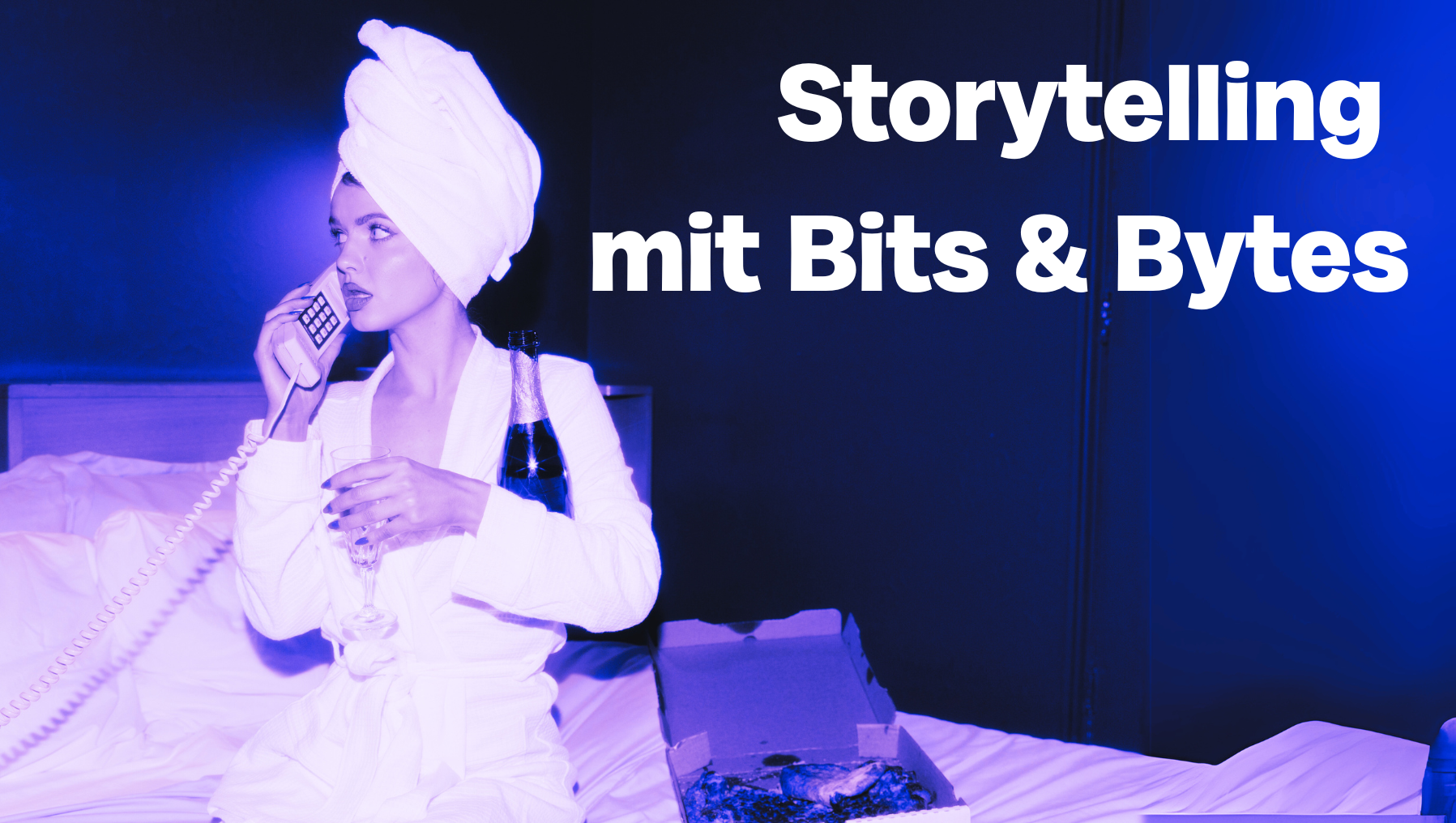The Employer Branding Funnel: Bringing Recruiting and Retention to Life with Storytelling

In today’s highly competitive world of work, employer branding has become a crucial factor in attracting and retaining the best talent. Our Employer Branding Funnel model offers a comprehensive approach to developing and maintaining a strong employer brand that radiates both internally and externally.
1. Awareness: Reach that Tells Stories
“I’ve heard of company XY.”
The first stage of the funnel focuses on building or expanding the reach of the employer brand. Various channels come into play here, including press, social media, advertisements, out-of-home campaigns and events. When we increase awareness, it’s not just about being seen, but also about being remembered. This is why figurative language and authentic messages already play a decisive role in this phase. The media are often interested in field reports from the business world. You can take advantage of this by transparently presenting a specific benefit program from your company. Just as AdvoService did in t3n, for example, thus covering an important target medium for tech talent.
2. Consideration: Employer Branding and Storytelling with Staying Power
“I follow company XY, you never know.”
Once the attention has been aroused, the next step is to deepen the interest of potential applicants. The consideration phase is largely measured in engagements and visits. If someone actively visits your website, follows your Instagram profile, has looked at a job advertisement, subscribes to your newsletter, then these are the first signs that they are thinking about staying in touch with your company.
The most important thing here is to create content offers that people like to follow in the long term. At this point, unused social media profiles or missing links can lead to the recruitment journey being aborted for technical reasons alone. Serial storytelling formats with long-term added value – such as our agency stories – in turn engage your talent audience. Existing employees can also be informed and inspired with content about the company, its values and people, even if these are external channels.
Find out more about how to engage talent on social media in our article on employer branding on LinkedIn.
3. Interest: Storytelling that Captivates
“I’m thinking about applying to company XY.”
Once interest has been aroused, the opportunity must be seized to provide an insight into the corporate culture that is as catchy and in-depth as possible. This creates an emotional bond with the brand among potential candidates. At the same time, authentic content offers the opportunity to check whether it is really a suitable company for the applicant. Every career page should therefore not only provide dry information, but also a narrative about your values, your mission and the experiences and corporate culture within your team.
The website becomes a book that potential applicants flip through to immerse themselves in the world of your employer brand. Measured in terms of dwell time, interest can of course be maintained primarily through stories, as Arineo’s digital companions do on their careers page. A well-told company newsletter can be just as effective in the employer branding funnel as videos that introduce the people behind the job advertisements.
More and more companies are tying in interest with audio formats such as podcasts. You can find out what this can look like in our blog post Audio storytelling in recruiting
4. Action: The Story Behind the Applications
“I’m applying.”
The fourth phase of the funnel is crucial – this is where actual action is expected. Of course, the application phase should run smoothly on both sides. But here too, storytelling can be used to conjure up more magic and a better match. Every application tells the story of an individual, his or her qualifications and motivation. So create incentives for applicants to tell more about themselves and their motivations. Cover letters and CVs are being redefined more and more these days.
Talk about particularly creative applications that were successful or invite talented people on your careers page to send a personal anecdote along with their documents. For example, t3n also reported on an application anecdote from our company based on a blog post. Personalized feedback that responds to applicants’ individual stories also creates a positive interaction and promotes loyalty, even if it ends up being a rejection.
If you don’t want to leave the application rate to chance, you can also use the success formula of storytelling on job descriptions and job pages.
5. Match: Interviews as Dialogical Stories
“Company XY finds me suitable and I find them suitable too.”
The match phase is an interactive narrative. Job interviews are not just question-and-answer sessions, but dialogs that interweave the applicant’s stories with the company’s values and goals. An interview process based on storytelling helps to assess the suitability of candidates within the employer branding funnel, not only on a professional but also on a cultural level.
You can find out how applicants become team players in our blog posts Storytelling in job interviews, Storytelling in onboarding, the brand book, and Communicating values in onboarding.
6. Retention: Employee loyalty through shared stories

“I’ve arrived here.”
The employer branding funnel does not end with the successful job interview. Employee loyalty is created when the individual stories of employees are aligned with the overarching story of the company. A company that promotes a culture of storytelling and exchange, appreciation and a culture of error creates a sense of belonging. Internal events that provide space for employee stories promote cohesion and strengthen the bond with the team. Especially during onboarding, it is important to quickly convey an understanding of the culture and established processes, and what better way to do this than with simple storytelling levers such as anecdotes, example stories, but also understandable, illustrated familiarization tutorials.
You can find inspiration for communicating values in everyday corporate life in our articles on storytelling for managers, for feedback discussions, and in our article on various formats for communicating values.
7. Reputation: Corporate Influencers Tell the Story
“I am in favor of company XY.”
A company’s reputation on platforms such as kununu, Glassdoor, or LinkedIn becomes a collective story. Corporate influencers who report authentically on their experiences spread the brand story and thus close the circle: new reach for new talent. However, this is not a sure-fire success. Companies should also create processes and provide resources for this. Corporate influencers often need motivation, inspiration and guidance to present themselves professionally on social media profiles and thus define their personal brand.
Find out more in our blog post about corporate influencers: How employees become brand ambassadors – and stay that way!
Overall, the connection between employer branding and storytelling shows that a strong employer brand is not only based on facts, but also on emotions and narratives. Companies that can fill the seven dimensions of the employer branding funnel with inspiring stories not only create a brand but also a world of experience that attracts and retains talent.
Share this article









